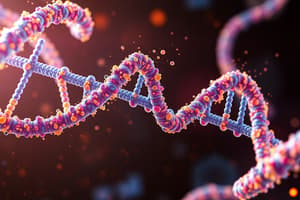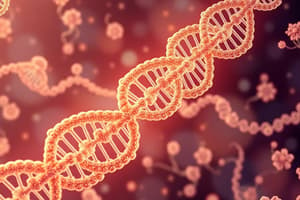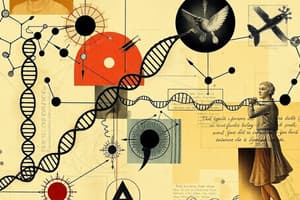Podcast
Questions and Answers
Which carbon atom of the sugar moiety within a nucleotide does the phosphate group typically attach to?
Which carbon atom of the sugar moiety within a nucleotide does the phosphate group typically attach to?
- C-2
- C-5 (correct)
- C-1
- C-3
What chemical process describes the reversible interconversion between keto (or lactam) and enol (or lactim) forms of purines and pyrimidines?
What chemical process describes the reversible interconversion between keto (or lactam) and enol (or lactim) forms of purines and pyrimidines?
- Isomerization
- Glycosylation
- Tautomerism (correct)
- Phosphorylation
Under physiological conditions, which tautomeric forms of purines and pyrimidines are most prevalent?
Under physiological conditions, which tautomeric forms of purines and pyrimidines are most prevalent?
- Enol and imino
- Keto and amino (correct)
- Lactim and amino
- Lactam and imino
What structural characteristic of the β-N-glycosidic bond in nucleotides limits free rotation and favors a specific conformation?
What structural characteristic of the β-N-glycosidic bond in nucleotides limits free rotation and favors a specific conformation?
Which of the following describes the predominant conformation of nucleotides around the glycosidic bond?
Which of the following describes the predominant conformation of nucleotides around the glycosidic bond?
Identify the nucleoside that corresponds to the base guanine.
Identify the nucleoside that corresponds to the base guanine.
What is the primary role of cyclic AMP (cAMP) and cyclic GMP (cGMP) within cells?
What is the primary role of cyclic AMP (cAMP) and cyclic GMP (cGMP) within cells?
Which of the following nucleotides is utilized in glycogenesis and the uronic acid pathway?
Which of the following nucleotides is utilized in glycogenesis and the uronic acid pathway?
Which of the following is a key structural difference between nucleosides and nucleotides?
Which of the following is a key structural difference between nucleosides and nucleotides?
If a newly discovered virus contains thymine as one of its pyrimidine bases, what can you conclude about its genetic material?
If a newly discovered virus contains thymine as one of its pyrimidine bases, what can you conclude about its genetic material?
A researcher isolates a modified nucleobase from a sample and identifies it as 5-methylcytosine. What is the most likely function of this modified base?
A researcher isolates a modified nucleobase from a sample and identifies it as 5-methylcytosine. What is the most likely function of this modified base?
Which of the following describes the type of bond that connects a sugar molecule to a nitrogenous base in a nucleoside?
Which of the following describes the type of bond that connects a sugar molecule to a nitrogenous base in a nucleoside?
How does the presence of methylated xanthines such as caffeine and theophylline impact cellular processes?
How does the presence of methylated xanthines such as caffeine and theophylline impact cellular processes?
If a scientist is studying a molecule and determines that it contains a nitrogenous base, a pentose sugar, and a phosphate group, what type of molecule is it?
If a scientist is studying a molecule and determines that it contains a nitrogenous base, a pentose sugar, and a phosphate group, what type of molecule is it?
Which nitrogenous bases are common to both DNA and RNA?
Which nitrogenous bases are common to both DNA and RNA?
A mutation in a DNA sequence leads to the replacement of cytosine with uracil. Which repair mechanism is most likely to correct this error?
A mutation in a DNA sequence leads to the replacement of cytosine with uracil. Which repair mechanism is most likely to correct this error?
Flashcards
Nucleotides
Nucleotides
Building units of nucleic acids; consist of a nitrogenous base, pentose sugar, and phosphate group.
Nucleic Acids
Nucleic Acids
Two main types: Deoxyribonucleic acid and Ribonucleic acid.
Nitrogenous Bases
Nitrogenous Bases
Heterocyclic ring compounds containing carbon and nitrogen.
Purines
Purines
Signup and view all the flashcards
Pyrimidines
Pyrimidines
Signup and view all the flashcards
Minor Bases
Minor Bases
Signup and view all the flashcards
Nucleosides
Nucleosides
Signup and view all the flashcards
β-N-glycosidic Bond
β-N-glycosidic Bond
Signup and view all the flashcards
What are nucleotides?
What are nucleotides?
Signup and view all the flashcards
Where does phosphate attach?
Where does phosphate attach?
Signup and view all the flashcards
What is tautomerism?
What is tautomerism?
Signup and view all the flashcards
Common forms at physiological pH?
Common forms at physiological pH?
Signup and view all the flashcards
Syn and anti conformers?
Syn and anti conformers?
Signup and view all the flashcards
Functions of nucleotides?
Functions of nucleotides?
Signup and view all the flashcards
Function of pyrimidine nucleotides?
Function of pyrimidine nucleotides?
Signup and view all the flashcards
What is S-adenosyl methionine (SAM)?
What is S-adenosyl methionine (SAM)?
Signup and view all the flashcards
Study Notes
Nucleotide Chemistry
- Purine and pyrimidine bases, along with their derivatives, form the building blocks of nucleic acids as nucleosides and nucleotides.
- There are two primary types of nucleic acids: Deoxyribonucleic acid (DNA) and Ribonucleic acid (RNA).
- Nucleotides, the building blocks of nucleic acids, consist of a nitrogenous base(purine or pyrimidine), a pentose sugar (ribose or deoxyribose), and a phosphate group.
Nitrogenous Bases
- They are heterocyclic ring compounds containing carbon and nitrogen.
- The two classes of nitrogenous bases are based on abundance within the cell: major bases and minor bases.
- Major bases are abundant and include purines and pyrimidines.
- Purines, such as adenine and guanine, are found in both DNA and RNA.
- Pyrimidines include cytosine, which is present in both DNA and RNA; thymine, found only in DNA; and uracil, present only in RNA.
Minor Bases
- Minor bases are present in trace amounts and are typically methylated, such as 5-methyl cytosine and N7-methylguanine.
- Minor bases serve important functions, including oligonucleotide recognition, regulating the half-life of RNAs, and protecting host DNA from digestion by DNases.
- Some bases exist in a free state inside cells, including xanthine, hypoxanthine, and uric acid.
- Methylated xanthines include caffeine (1,3,7 trimethyl xanthine) in coffee, theophylline (1,3 dimethyl xanthine) in tea, and theobromine (3,7 dimethyl xanthine) in coca.
Nucleosides
- They consist of a base and a sugar (either ribose or deoxyribose).
- Sugars attach to bases via a covalent, β-N-glycosidic bond, linking the C₁ of the sugar with N-9 of a purine or N-1 of a pyrimidine.
- A prime notation (e.g., 3
or 5) helps to distinguish atoms in the sugar from those in the base.
Nucleotides
- They are composed of a base, sugar, and phosphate group.
- The phosphate group attaches to the C-5 position of the sugar.
Tautomerism
- Purines exist in two isoforms: keto (or lactam) and enol (or lactim) forms, as well as amino (-NH2) and imino (=NH) forms.
- Tautomerism refers to the change from one form to another.
- Keto and amino forms are prevalent under physiological pH conditions.
Syn and Anti-Conformers
- Nucleotides exist in stable, non-interconvertible syn and anti conformations.
- The β-N-glycosidic bond forms a firm bond that restricts rotation.
- Conversion from one conformer to another requires the rupture and reformation of the glycosidic bond
- The anti-conformer is the predominant form.
Functions of Nucleotides
- Both purine and pyrimidine nucleotides are elemental in the construction of nucleic acids like DNA and RNA.
- Purine nucleotides are essential for high-energy storage molecules such as ATP and GTP.
- As intracellular signals cAMP and cGMP act as secondary messengers for many hormones.
- They form the base of many coenzymes like NAD, NADP, FAD, and FMN, involved in hydrogen transfer, and COASH, which is involved in acid transfer.
- They act as the active methyl donor (S-adenosyl methionine, or SAM).
- They act as the active sulfate donor (3'phosphoadenosine-5'-phosphosulfate, or PAPS).
- Nucleotides such as ADP regulate rates of oxidative phosphorylation in the mitochondria.
- Pyrimidine nucleotides participate in the formation of high-energy intermediates: -Uridine diphosphate glucose (UDP-glucose), is crucial in glycogenesis and the uronic acid pathway.
- Pyrimidine nucleotides are also involved in high-energy storage as CTP and UTP.
Studying That Suits You
Use AI to generate personalized quizzes and flashcards to suit your learning preferences.





